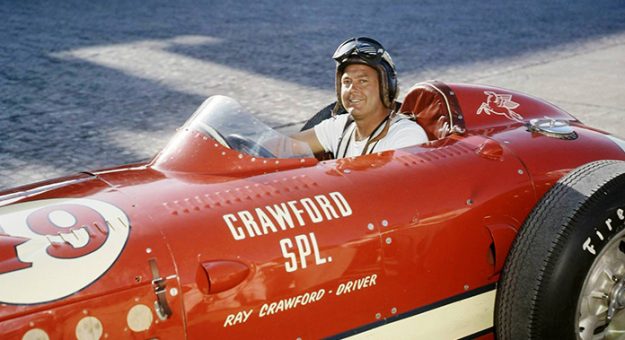“After you’ve raced, the sky is bluer, the steaks are better and the girls are prettier,” stated Ray Crawford, attempting to describe racing’s irresistible seduction.
Money certainly didn’t entice him to the sport. His family owned the ultra-successful Crawford Markets, which were scattered throughout Southern California and into Mexico.
Started by his parents as a watermelon stand in Alhambra, Calif., their sales in 1955 were $22 million. That’s nearly a quarter billion in today’s dollars.
Born on Oct. 26, 1915, the outbreak of WWII became the catalyst for Crawford’s audacious and adventuresome spirit. He joined the Army Air Force and flew P-38s with the 12th Air Force Fighter Group over North Africa. Flying more than 50 combat missions, he blew six Nazi fighters out of the sky and earned ace status.
Transferred from the front lines, Crawford continued his bold air escapades as a test pilot for America’s first fighter jet, the Lockheed P-80. If he didn’t grasp the danger he encountered daily before, he certainly did after one eerie instance.
Shortly after takeoff, Crawford aborted a P-80 test flight because of mechanical problems. The plane finally repaired, America’s top-scoring WWII ace, Major Richard Bong, with whom Crawford rotated flights, took the next mission. The P-80 crashed and Bong perished.
By the time Crawford was discharged as a captain in 1946, along with a host of other commendations, he’d won the Distinguished Flying Cross and the Air Medal with 14 Oak Leaf Clusters.
Following World War II, many former soldiers encountered difficulty settling into the day-by-day routine of civilian life. Some turned to auto racing to appease that restlessness. Crawford was one.
“You dive a plane or drive a car at maximum velocity,” he once said, “it’s a special area of living you can’t describe to anyone else. They can’t understand.”
Midget racing was in the midst of its post-war boom and it caught Crawford’s attention. In 1947, he attempted racing a midget for the first time at California’s Culver City Speedway, a quarter-mile dirt bowl.
“They called me the Millionaire Playboy,” Crawford once joked. “I got in a race car, sat down and put on a helmet and goggles. I looked like a race driver, anyway.”
In reality, he more than looked like a race car driver. He did well. He was particularly adept at Gilmore Stadium against some of the toughest midget competition in the nation.
In addition to his midget racing, Crawford manhandled sports cars, charged up Pikes Peak and even raced unlimited hydroplanes on Lake Mead. In 1955, Crawford wrestled his Kurtis/Lincoln sports car around Sebring (Fla.) Int’l Raceway for the 12 hours without a co-driver. That feat has never been duplicated.
In 1957, he finished seventh and fourth in two of three heats on Monza’s concrete high banks during the Race of Two Worlds.
Perhaps, Crawford’s most telling demonstration of ability and fortitude, however, came in the 1954 Pan-American Road Race. He competed in the five-day, 1,900-mile odyssey across Mexico in his privately owned Lincoln and won the stock car class.
Where he desperately wanted to shine, though, was Indianapolis. The 500 hooked him in 1952 when he served as a crew member for Sam Hanks. He bought a new Kurtis roadster for the 1953 race, but officials turned him away for lack of experience.
He passed his rookie test in 1954 and finally made the field of 33 in 1955. His speed was third quickest of the four days of time trials and would’ve put him on the front row had the run happened on Pole Day.
He qualified again in 1956, then missed two years because of pressing business projects. In 1959, he squeezed his Watson copy into the field in 32nd spot and worked his way steadily forward until a crash ended his day, and his career.
